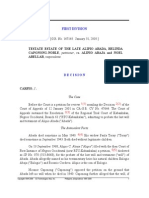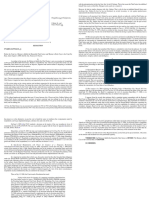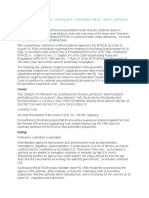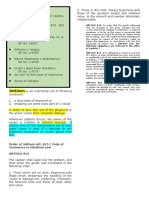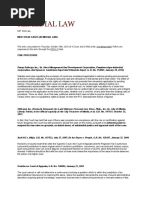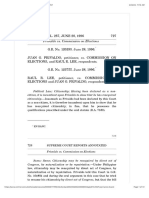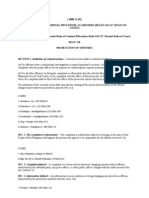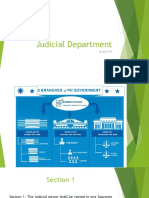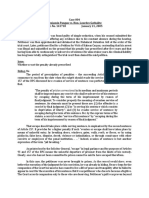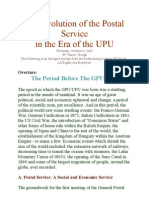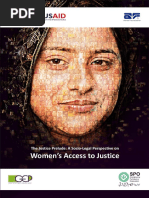US v. Limsiongco
US v. Limsiongco
Uploaded by
Andrea JuarezCopyright:
Available Formats
US v. Limsiongco
US v. Limsiongco
Uploaded by
Andrea JuarezOriginal Title
Copyright
Available Formats
Share this document
Did you find this document useful?
Is this content inappropriate?
Copyright:
Available Formats
US v. Limsiongco
US v. Limsiongco
Uploaded by
Andrea JuarezCopyright:
Available Formats
243 | Judicial Dept One Supreme Court
The United States Vs.M. J. Limsiongco, Vicente Yap, Yap Bun, Tan Fong, Sing Joy, Chino
Saya (Alias) Isaias Javier, Lim Liongco, Sing Yang, Lorenzo Pavia And Mariano Tan-Congco
G.R. No. L-16217; October 9, 1920; MALCOLM, J.:
FACTS OF THE CASE:
Within the time allowed by the Rules of the Court, counsel for appellants have raised a most
interesting question unconnected with the merits of the particular case, but assailing the very
structure of the court itself. Appellant's motion is based "on the ground that the instant decision was
rendered by a division of the court and not by the body constituted by law for the purpose, and
hence the decisions as rendered, was rendered by a body outside the law and having no power,
authority or jurisdiction to render a final decision in the controversy." In answer, the Attorney-General
submits "that section 138 of the Administrative Code permitting and authorizing the Supreme Court
to sit in division only touches and affects the matter of practice and method of procedure of said
court, which the acts of Congress . . . clearly authorized the Legislature to do."
The portion of the law which authorizes divisions in the Supreme Court is found in section 138 of the
Administrative Code of 1917, reading as follows:
SEC. 138. Sessions of court in banc and in divisions. The Supreme Court shall, as a body, sit in banc, but
it may sit in divisions to transact business for which four judges constitute a quorum, and two divisions may sit
at the same time. If the Chief Justice is present, whether in banc or division, he shall preside. In his absence,
that one of the judges attending in banc or in the division shall reside who holds the senior commission.
Six of the judges of the Supreme Court, lawfully convened, shall be necessary to form a quorum for the
transaction of any business involving the admiralty jurisdiction of the court, or for the final disposition of a civil
case in which the amount in controversy exceeds ten thousand pesos or a criminal case in which the
judgment of the lower court imposed death, or imprisonment for more than ten years, or a fine of more than
ten thousand pesos, and the concurrence of five judges, shall be necessary for the pronouncement of a
judgment, but when there is a vacancy in said court five judges shall constitute such quorum, and the
concurrence of four shall suffice for the pronouncement of the judgment. In all other case the presence of four
judges shall be sufficient to form a quorum, and the concurrence of three judges for the pronouncement of a
judgment.
In the absence of a quorum the court shall stand ipso facto adjourned until such time as the requisite number
shall be present, and a memorandum showing this fact shall be inserted by the clerk in the minutes of the
court.
ISSUE: whether or not section 138 of the Administrative Code infringes any of these constitutional
provision.
HELD: NO.
We think not. There is but one Supreme Court of the Philippine Islands. It is the jurisdiction of this
Supreme Court which cannot be diminished. The Supreme Court remains a unit notwithstanding it
works in divisions. Although it may have two divisions, it is but a single court. Actions considered in
any one of these divisions and decisions rendered therein are, in effect, by the same Tribunal. The
two divisions of this court are not to be considered as two separate and distinct courts but as
divisions of one and the same court. In the exact words of the law which is questioned, "the
Supreme Court shall, as a body, sit in banc, but it may sit in divisions . . . ."
The Legislature has merely attempted to regulate the organization of the court in a way not
prohibited by any constitutional provision. The constitution of divisions has been permitted for
convenience and the prompt dispatch of business. The provisions in no way involves the question of
jurisdiction.
We hold that the Philippine Legislature had power to enact law authorizing the Supreme Court to sit
either in banc or in divisions to transact business.
You might also like
- Judge Dale The Great American Adventure. Secrets of AmericaDocument92 pagesJudge Dale The Great American Adventure. Secrets of AmericaBrian Kelly95% (59)
- Administrative Law in Tanzania. A Digest of CasesFrom EverandAdministrative Law in Tanzania. A Digest of CasesRating: 4.5 out of 5 stars4.5/5 (12)
- Mangelen Vs CADocument2 pagesMangelen Vs CAAndrea Juarez100% (1)
- JCI SPONSORSHIP LetterDocument2 pagesJCI SPONSORSHIP LetterLexee DayanghirangNo ratings yet
- Rizal Sukma Indonesia and China The Politics of A Troubled RelationshipDocument235 pagesRizal Sukma Indonesia and China The Politics of A Troubled RelationshipDiaz MahasinzNo ratings yet
- Nautica Canning Corporation vs. YumulDocument14 pagesNautica Canning Corporation vs. YumulMiw CortesNo ratings yet
- Avelino V CuencoDocument2 pagesAvelino V Cuencocatrina lobatonNo ratings yet
- CALALANGDocument2 pagesCALALANGArgel Joseph CosmeNo ratings yet
- Inter-Asia Investment Indusstries Inc. vs. CA (G.R. No. 125778 June 10, 2003)Document3 pagesInter-Asia Investment Indusstries Inc. vs. CA (G.R. No. 125778 June 10, 2003)eunice demaclidNo ratings yet
- Constitutional Law I Cases - 2013Document10 pagesConstitutional Law I Cases - 2013Dian ObligacionNo ratings yet
- 1 12 Ferrer V PecsonDocument2 pages1 12 Ferrer V PecsonVenice Jamaila DagcutanNo ratings yet
- RuleDocument98 pagesRuleLeslie Ann DestajoNo ratings yet
- De Joya Vs CADocument2 pagesDe Joya Vs CAElead Gaddiel S. Albuero100% (1)
- Estrada V DesiertoDocument4 pagesEstrada V DesiertoLiz LorenzoNo ratings yet
- 1.in The Matter of James Joseph HammDocument12 pages1.in The Matter of James Joseph HammJoanna Mandap100% (1)
- A. Duties and Responsibilities To The Society PDFDocument14 pagesA. Duties and Responsibilities To The Society PDFMai Lin Granados100% (1)
- Hermosisima vs. CADocument4 pagesHermosisima vs. CAJane Dela CruzNo ratings yet
- Syllabus - Civil Procedure (JAC)Document32 pagesSyllabus - Civil Procedure (JAC)Zedy MacatiagNo ratings yet
- Funa Vs Duque IIIDocument39 pagesFuna Vs Duque IIIMaribel Nicole LopezNo ratings yet
- Dela Rosa vs. RoldanDocument11 pagesDela Rosa vs. RoldanAnakataNo ratings yet
- Testate Estate of Abada v. Abaja, 450 SCRA 264Document16 pagesTestate Estate of Abada v. Abaja, 450 SCRA 264Florz GelarzNo ratings yet
- Jimenez v. Cabangbang, 17 SCRA 876Document5 pagesJimenez v. Cabangbang, 17 SCRA 876Marianne VillacampaNo ratings yet
- The Consolidated Bank and Trust Corporation (SOLIDBANK), Petitioner, vs. DEL MONTE MOTOR WORKS, INC., NARCISO G. MORALES, 1 AND SPOUSE, RespondentsDocument3 pagesThe Consolidated Bank and Trust Corporation (SOLIDBANK), Petitioner, vs. DEL MONTE MOTOR WORKS, INC., NARCISO G. MORALES, 1 AND SPOUSE, RespondentsAviLopezNo ratings yet
- Garcia CRIMDocument85 pagesGarcia CRIMSam SamNo ratings yet
- Reyes vs. BaldeDocument2 pagesReyes vs. BaldeJaneen ZamudioNo ratings yet
- PubCorp Quiz #1Document9 pagesPubCorp Quiz #1Keisha Yna V. RamirezNo ratings yet
- Padilla vs. CA, 129 SCRA 558Document4 pagesPadilla vs. CA, 129 SCRA 558JP DCNo ratings yet
- Facts:: ELISEO F. SORIANO v. MA. CONSOLIZA P. LAGUARDIA, GR No. 164785, 2009-04-29Document2 pagesFacts:: ELISEO F. SORIANO v. MA. CONSOLIZA P. LAGUARDIA, GR No. 164785, 2009-04-29angelica balatongNo ratings yet
- Jettison: Order of Jettison Art. 815 (Code of Commerce in Maritime Law Article 815Document16 pagesJettison: Order of Jettison Art. 815 (Code of Commerce in Maritime Law Article 815Pavi Antoni VillaceranNo ratings yet
- REMEDIAL LAW Must Read CasesDocument47 pagesREMEDIAL LAW Must Read CasesCrest PedrosaNo ratings yet
- Frivaldo V COMELECDocument72 pagesFrivaldo V COMELECAU SLNo ratings yet
- G.R. No. L-17722 October 9, 1961 MAURICIO GORDULAN, Plaintiff-Appellee, CESAREO GORDULAN, Defendant-AppellantDocument2 pagesG.R. No. L-17722 October 9, 1961 MAURICIO GORDULAN, Plaintiff-Appellee, CESAREO GORDULAN, Defendant-AppellantAjpadateNo ratings yet
- Civpro Midterms 2Document27 pagesCivpro Midterms 2Carina Amor ClaveriaNo ratings yet
- Gokongwei Jr. v. SECDocument6 pagesGokongwei Jr. v. SECspringchicken88No ratings yet
- A Lawyer Shall Not Refuse His Services To The NeedyDocument13 pagesA Lawyer Shall Not Refuse His Services To The NeedyJames Joshua AzasNo ratings yet
- Admin Elect Public CorpDocument27 pagesAdmin Elect Public CorpJohn Ramil RabeNo ratings yet
- United States vs. Pons, 34 Phil 729Document6 pagesUnited States vs. Pons, 34 Phil 729Illia ManaligodNo ratings yet
- En Banc: Syllabus SyllabusDocument6 pagesEn Banc: Syllabus SyllabusKristinaCastellanoNo ratings yet
- Crim Pro CasesDocument5 pagesCrim Pro CasesJanelle MupasNo ratings yet
- Article VI. Legislative DepartmentDocument26 pagesArticle VI. Legislative DepartmentRichelle Ruth100% (1)
- 3memaid Poli Consti 2008Document74 pages3memaid Poli Consti 2008Fernan Del Espiritu SantoNo ratings yet
- When Is A Donation PerfectedDocument7 pagesWhen Is A Donation PerfectedjcgalamgamNo ratings yet
- Alliance For Alternative Action: The Adonis Cases 2011Document171 pagesAlliance For Alternative Action: The Adonis Cases 2011Vince Llamazares LupangoNo ratings yet
- Joint Motion To Dismiss: Regional Trial Court of Lanao Del NorteDocument1 pageJoint Motion To Dismiss: Regional Trial Court of Lanao Del NorteBruce WayneNo ratings yet
- Crimproc 1Document57 pagesCrimproc 1BeethovenMarkNo ratings yet
- Petitioners vs. VS.: en BancDocument45 pagesPetitioners vs. VS.: en BancDuffy DuffyNo ratings yet
- Digested CasesDocument12 pagesDigested CasesVenessa Salazar BarbiranNo ratings yet
- Galman V Pamaran en Banc G.R. Nos. 71208-09 August 30 1985Document77 pagesGalman V Pamaran en Banc G.R. Nos. 71208-09 August 30 1985herbs22225847No ratings yet
- BM No. 2265: Reforms in The 2011 Philippine Bar Exam (Bar Examinations Were Moved From September 2011 To November 2011)Document5 pagesBM No. 2265: Reforms in The 2011 Philippine Bar Exam (Bar Examinations Were Moved From September 2011 To November 2011)Frederick GellaNo ratings yet
- SEC Opinion No. 06-20 PDFDocument3 pagesSEC Opinion No. 06-20 PDFTrisha Fernandez100% (1)
- The Constitution of The Philippines 1. de Leon v. Esguerra Case DigestDocument18 pagesThe Constitution of The Philippines 1. de Leon v. Esguerra Case DigestEunice IquinaNo ratings yet
- G.R. 195229 Ara Tea Vs Comelec Full TextDocument16 pagesG.R. 195229 Ara Tea Vs Comelec Full TextDino Bernard LapitanNo ratings yet
- Ethics Digests CompiledDocument187 pagesEthics Digests CompiledVinz G. Viz100% (1)
- Lotus To Marcos Case FinalDocument8 pagesLotus To Marcos Case FinalCharm PedrozoNo ratings yet
- Retroactive Effect of Penal LawsDocument4 pagesRetroactive Effect of Penal LawsHazel Reyes-AlcantaraNo ratings yet
- Codilla v. de VeneciaDocument46 pagesCodilla v. de VeneciaDianneNo ratings yet
- Romero V Estrada PDFDocument13 pagesRomero V Estrada PDFyousirneighmNo ratings yet
- 2019 Bar Review Lecture On Judicial Ethics - by Atty Loanzon PDFDocument18 pages2019 Bar Review Lecture On Judicial Ethics - by Atty Loanzon PDFBrave NeventuraNo ratings yet
- Senate of PH Vs ErmitaDocument37 pagesSenate of PH Vs ErmitaGraceNo ratings yet
- PFR NotesDocument73 pagesPFR Notesdir sinNo ratings yet
- Section 11. The Provincial Fiscal or The City Fiscal ShallDocument2 pagesSection 11. The Provincial Fiscal or The City Fiscal ShallAnonymous mv3Y0KgNo ratings yet
- James R. Jackson, Individually and As Administrator of The Estate of Sandra A. Jackson v. City of Joliet, 465 U.S. 1049 (1984)Document2 pagesJames R. Jackson, Individually and As Administrator of The Estate of Sandra A. Jackson v. City of Joliet, 465 U.S. 1049 (1984)Scribd Government DocsNo ratings yet
- SiongcoDocument6 pagesSiongcoAnna Fe SyNo ratings yet
- Judicial Department: Article VIIIDocument33 pagesJudicial Department: Article VIIIRhiza Marie MonaresNo ratings yet
- Oil and Natural Gas Commission V CADocument2 pagesOil and Natural Gas Commission V CAAndrea Juarez100% (1)
- Pimentel V OchoaDocument3 pagesPimentel V OchoaAndrea JuarezNo ratings yet
- Victorias Milling V SSCDocument2 pagesVictorias Milling V SSCAndrea Juarez100% (1)
- Senate V ErmitaDocument3 pagesSenate V ErmitaAndrea JuarezNo ratings yet
- Sanidad V ComelecDocument3 pagesSanidad V ComelecAndrea JuarezNo ratings yet
- Republic of The Philippines vs. Pablo Feliciano and Iac G.R. No. 70853 March 12, 1987Document2 pagesRepublic of The Philippines vs. Pablo Feliciano and Iac G.R. No. 70853 March 12, 1987Andrea JuarezNo ratings yet
- Meyer V State of NebraskaDocument1 pageMeyer V State of NebraskaAndrea JuarezNo ratings yet
- People V TorpioDocument1 pagePeople V TorpioAndrea JuarezNo ratings yet
- People V VillacortaDocument2 pagesPeople V VillacortaAndrea JuarezNo ratings yet
- 286 Delos Santos Vs YatcoDocument2 pages286 Delos Santos Vs YatcoAndrea Juarez100% (1)
- People V WhisenhuntDocument2 pagesPeople V WhisenhuntAndrea JuarezNo ratings yet
- People V TolentinoDocument2 pagesPeople V TolentinoAndrea JuarezNo ratings yet
- Pangan V GatbaliteDocument2 pagesPangan V GatbaliteAndrea Juarez100% (1)
- People V SanidadDocument2 pagesPeople V SanidadAndrea Juarez100% (2)
- 266 Borromeo v. CADocument2 pages266 Borromeo v. CAAndrea JuarezNo ratings yet
- 244 Diaz v. CADocument2 pages244 Diaz v. CAAndrea Juarez100% (3)
- People V Chua HiongDocument2 pagesPeople V Chua HiongAndrea Juarez100% (2)
- 261 Valbueco V Province of BataanDocument2 pages261 Valbueco V Province of BataanAndrea JuarezNo ratings yet
- 260 Tin V PeopleDocument3 pages260 Tin V PeopleAndrea JuarezNo ratings yet
- Fortich Vs CoronaDocument2 pagesFortich Vs CoronaAndrea JuarezNo ratings yet
- 249 Dulay V JBCDocument1 page249 Dulay V JBCAndrea JuarezNo ratings yet
- 285 SSS Employees Association vs. CADocument2 pages285 SSS Employees Association vs. CAAndrea JuarezNo ratings yet
- Certified List of Candidates For Congressional and Provincial Positions For The May 13, 2013 2013 National, Local and Armm ElectionsDocument2 pagesCertified List of Candidates For Congressional and Provincial Positions For The May 13, 2013 2013 National, Local and Armm ElectionsSunStar Philippine NewsNo ratings yet
- Report Why Are Boys Underperforming FINALDocument42 pagesReport Why Are Boys Underperforming FINALMady IsanNo ratings yet
- Convention Against TortureDocument11 pagesConvention Against Torture80082583100% (1)
- The Globalization of Popular MusicDocument10 pagesThe Globalization of Popular MusicMayeth Silva GonzalesNo ratings yet
- Case of Galotskin v. GreeceDocument21 pagesCase of Galotskin v. GreecearepatraNo ratings yet
- Script Video Report RizalDocument9 pagesScript Video Report Rizalmariaisabelle DuganNo ratings yet
- Cosnita Andreea Florentina - Comparison Between The System of Government Romania - The United KingdomDocument4 pagesCosnita Andreea Florentina - Comparison Between The System of Government Romania - The United KingdomAndy AndreeaNo ratings yet
- Dictionnaire de La Révolution HaitienneDocument13 pagesDictionnaire de La Révolution HaitienneEddy LagroueNo ratings yet
- SBI PO Preliminary Model Paper 16Document43 pagesSBI PO Preliminary Model Paper 16Anonymous ey6J2bNo ratings yet
- Rizal in MadridDocument9 pagesRizal in MadridLorie jane100% (1)
- All Interdisciplinary CoursesDocument179 pagesAll Interdisciplinary CoursesdeepNo ratings yet
- Local Government in PakistanDocument14 pagesLocal Government in PakistanIshfaq AhmadNo ratings yet
- Proc 587 Ethiopia Revenues and CustomsDocument12 pagesProc 587 Ethiopia Revenues and Customsbini100% (2)
- Application T.M. 8Document2 pagesApplication T.M. 8Benjamin MedinaNo ratings yet
- Rule 3 s12 - Mathay Vs Consolidated Bank and Trust CompanyDocument1 pageRule 3 s12 - Mathay Vs Consolidated Bank and Trust CompanyLoury Luzadio100% (1)
- Sec 35-37 Powers of CorporationDocument10 pagesSec 35-37 Powers of CorporationJoana Trinidad100% (1)
- The Evolution of The Postal ServiceDocument21 pagesThe Evolution of The Postal ServiceilluminelNo ratings yet
- 5 - Dimensions of DiversityDocument1 page5 - Dimensions of DiversityTanya BroshNo ratings yet
- Plaintiff Spine Imaging MRI LLC Response To Interrogatories PDFDocument5 pagesPlaintiff Spine Imaging MRI LLC Response To Interrogatories PDFCamdenCanaryNo ratings yet
- Women Access To Justice PDFDocument163 pagesWomen Access To Justice PDFdogarsahabNo ratings yet
- Study Material For Business RegulationsDocument122 pagesStudy Material For Business RegulationsViraja GuruNo ratings yet
- STAT170 Research 3Document4 pagesSTAT170 Research 3Biyan HariyantoNo ratings yet
- What Is Patriotism?Document3 pagesWhat Is Patriotism?Kristina AngelinaNo ratings yet
- JSSC - Admit CardDocument2 pagesJSSC - Admit CardSuraj KumarNo ratings yet
- Constitutional Law I-Governmental Structure, OutlineDocument21 pagesConstitutional Law I-Governmental Structure, OutlineConnor EwingNo ratings yet
- Ucc PDFDocument8 pagesUcc PDFAbhinav SwarajNo ratings yet
- The Challenge of Eurocentrism, Global Perspectives, Policy, and Prospects, by Rajani Kannepalli Kanth - PDFDocument296 pagesThe Challenge of Eurocentrism, Global Perspectives, Policy, and Prospects, by Rajani Kannepalli Kanth - PDFJiyaNo ratings yet




















